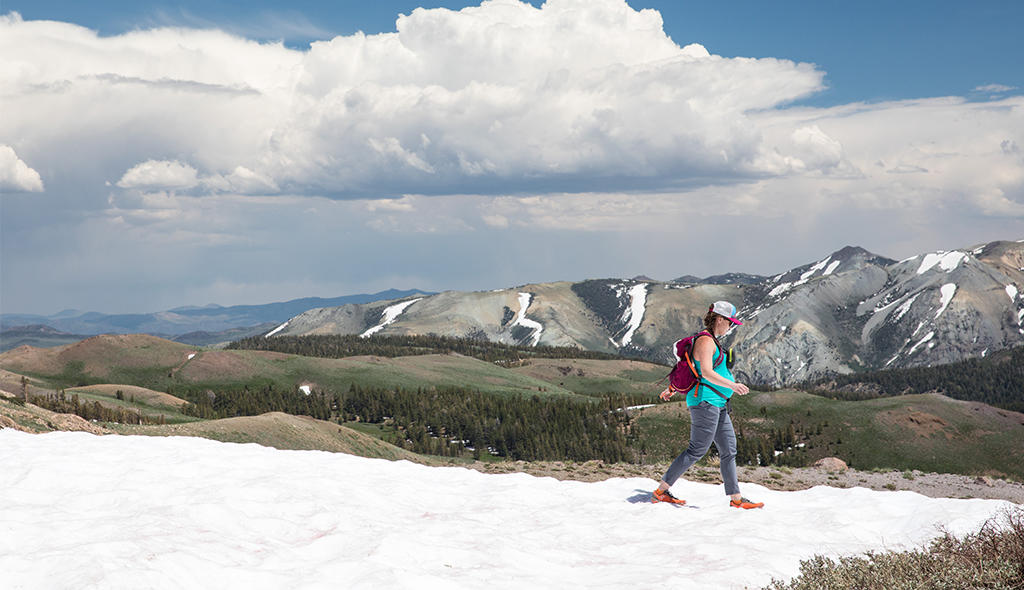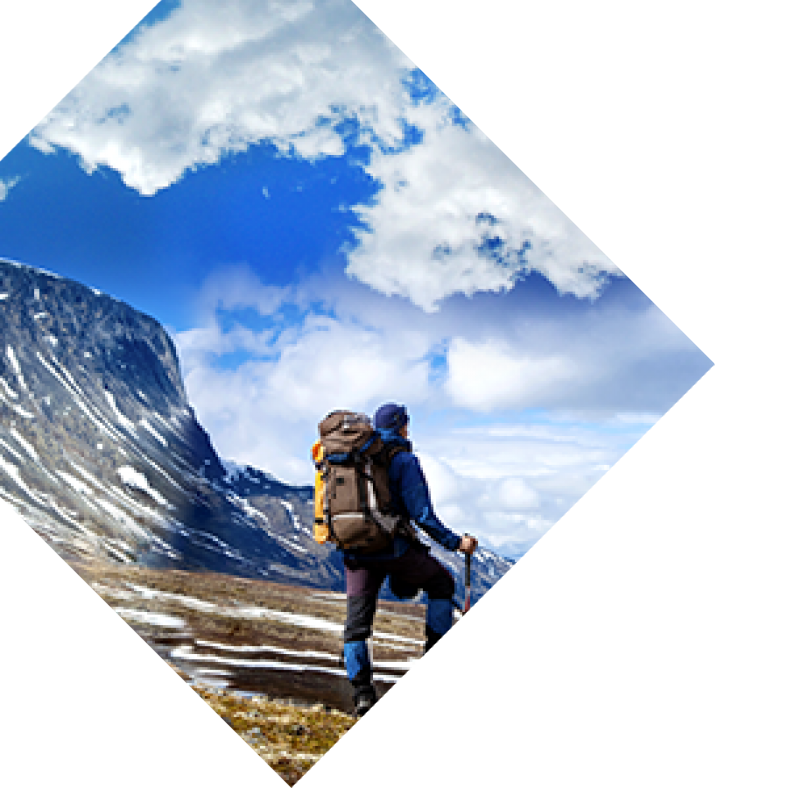 I came to the realization very early in my pregnancy that everyone had an opinion. This became very clear every time I put foot to trail in an effort to go hiking. Take it easy out there, mama! Good for you; that will be one tough kid! You’re still hiking? How far along are you? The comments and questions I received while exploring the mountains ran the gamut from well-meaning support to extreme concern as to whether I was endangering my not-yet-born child. I finally learned to brush off external comments and trust myself. My doc had given me the green light for hiking and I personally felt great, so I banished the naysayers from my mind. Because here is the thing: hiking while pregnant is a safe activity, assuming your doctor approves. It is a low-impact form of exercise that is great for both cardio and muscular strength. Even more? It worked wonders for my mental state, which was critical as I worked my way through the nine-month pregnancy. But just like everything else during pregnancy, there are special considerations involved when hitting the trail with that baby bump. Check out these tips to ensure you have the safest hike possible for you and your bundle of joy.
I came to the realization very early in my pregnancy that everyone had an opinion. This became very clear every time I put foot to trail in an effort to go hiking. Take it easy out there, mama! Good for you; that will be one tough kid! You’re still hiking? How far along are you? The comments and questions I received while exploring the mountains ran the gamut from well-meaning support to extreme concern as to whether I was endangering my not-yet-born child. I finally learned to brush off external comments and trust myself. My doc had given me the green light for hiking and I personally felt great, so I banished the naysayers from my mind. Because here is the thing: hiking while pregnant is a safe activity, assuming your doctor approves. It is a low-impact form of exercise that is great for both cardio and muscular strength. Even more? It worked wonders for my mental state, which was critical as I worked my way through the nine-month pregnancy. But just like everything else during pregnancy, there are special considerations involved when hitting the trail with that baby bump. Check out these tips to ensure you have the safest hike possible for you and your bundle of joy.
Chat with Your Doctor
Before you do anything, it is a good idea to have a conversation with your OB. If you were active before pregnancy, he or she will likely have no problem with you hiking during pregnancy. However, there are some complications that may be specific to you, so clear everything with him before heading into the mountains.
Carefully Evaluate the Terrain
Here in Colorado, I normally spend a lot of time scaling large mountains and technical terrain. However, I opted to scale back the difficulty while I was hiking for two. As I progressed through my pregnancy, my belly grew larger as I added more than 50 pounds to my pre-pregnancy body. This added weight on my front side really threw off my center of gravity, making it easier for me to pitch forward. To combat this, it’s not a bad idea to stick to easier trails with less of elevation gain and fewer technical sections that could cause tripping. The big peaks will still be there for you next season!
Stay Low
This may not affect everyone, but it is a good idea to consider the altitude before embarking on a hike. In Colorado, the majority of our typical hikes take place above tree line, or above 12,000 feet where the views are the best. However, my doc requested that I stay below 12k for the duration of my pregnancy. Why? There is less oxygen available to you at higher elevations, which means there is also less available to your baby. Some studies have shown that less oxygen can negatively impact a baby, causing lower birth weights (among other concerns). But here is the catch: high altitude is a relative concept, depending on where you live. Since I regularly hike 14ers (peaks above 14,000 feet), staying below 12k was a reasonable compromise. However, if you permanently reside at sea level, altitudes of 6,000-7,000 feet are going to leave you breathless. Talk with your doc before hiking at a higher-to-you altitude and figure out a game plan.
Stay Hydrated
If you are already pregnant, you’ve likely noticed that you are constantly thirsty, and this is only exacerbated on the trail. Between the hot sun, the physical exertion, and the constant sweating, it is very easy for a mama-to-be to become quickly dehydrated. Consider this before heading out, and be sure to account for your newfound thirst.
Carry on a Conversation
For me, this rule was most applicable during my first trimester. While many people encourage pregnant women to track their heart rate in order to keep it below 140, my doc suggested that I maintain an exertion level that allowed me to carry on a conversation without gasping for breath. Not only does this protect Mom from pushing it too hard on the trail, but it also protects baby, too.
Check Your Weight
I’m not talking about the number on the scale! Rather, I’m referencing the amount of weight you are carrying in your backpack. (Because, of course, you are still taking the necessary safety precautions and hiking with the Ten Essentials, right?!) Carrying a heavy pack up a mountain is a surefire way to send your heart rate off the charts and leave you gasping for air, especially late in your pregnancy. That said, it is OK to carry some weight; just be aware you likely won’t be carrying as much as you have in the past. If you decide to go backpacking while pregnant, talk with your hiking partner ahead of time. Be sure he or she understands that he may need to carry more than his usual allotment of gear.
Bring Your Cell Phone
OK, I know hiking is where you go to get away from phone calls and work and the sounds of the city, and usually I am a strong advocate of ditching the gadgets at home. However, it is important to have a means of communication with you, especially if you are hiking in your third trimester when baby could arrive any day. If you hate the phone (I don’t blame you!), shut it off and stow it away in your backpack. That way, you don’t need to hear or see any annoying beeps or text messages, but you still have a way to call for help should baby decide to make a surprise appearance.
Stretch it Out
As I gained weight, I noticed my ankles and feet took a beating during hikes. Not only were my feet sorer, but my ankles became prone to rolling under the added load. To help with this, I regularly stretched my feet during my hikes. First, I’d point and flex my toes about 10-20 times on each foot. Then, I’d roll my ankles to left and to the right. Not only did it prevent soreness in my feet, but it helped keep calf cramps away too.
Go Shopping
I hate to break it to you, but your usual hiking apparel just won’t cut it! I was able to wear my normal stuff through my first trimester, but my belly grew too large after that. Unfortunately, there are not a lot of options for pregnant women who want to stay hiking. Yoga pants or other types of stretchy pants are a popular option, and I invested in two pairs of stretchy capris (in a size larger than I usually wear). I was able to wear both pairs until I hit 36 weeks, as long as I tucked the waist band below my belly. I also purchased two or three workout tanks that came in a loose fit. When combined with the larger sizing, I was able to wear both tops throughout the duration of my pregnancy. Finally, invest in a good quality sports bra. As you near your due date, your breasts will likely grow and you won’t be able to fit into your old bras (Trust me; you’ll need the support!) Additionally, it may be worth your while to snag a nursing sports bra if you plan on breastfeeding after giving birth. There is a chance you can wear this bra postpartum, and nursing bras truly are helpful.
You Do You
Lastly, tune it to what is best for yourself. No one knows your body as well as you do, so listen to what it is telling you. Get out there, have fun, and make some memories to share with baby later on in life.


